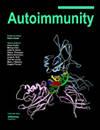MiR-361-5p在类风湿关节炎中通过靶向ZBTB10促进成纤维细胞样滑膜细胞增殖并抑制细胞凋亡
IF 3.3
4区 医学
Q3 IMMUNOLOGY
引用次数: 1
摘要
本研究旨在探讨miR-361-5p在类风湿关节炎(RA)成纤维细胞样滑膜(FLS)细胞中的关键作用并探讨其潜在机制。首先,我们采用RT-qPCR方法评估miR-361-5p在RA患者滑膜组织和培养的RA- fls细胞中的表达。然后通过CCK-8法、EdU染色、Western blot、流式细胞术和ELISA检测抑制miR-361-5p对RA-FLS细胞的影响。此外,我们使用生物信息学分析来预测miR-361-5p的潜在靶标,并进行双荧光素酶报告试验进行验证。最后,通过挽救实验证明miR-361-5p/锌指和BTB Domain Containing 10 (ZBTB10)在RA-FLS的增殖、细胞周期和凋亡中的作用。结果我们发现miR-361-5p在RA组织和培养的RA- fls细胞中的表达均升高。抑制miR-361-5p不仅可以抑制细胞增殖,使细胞周期停留在G1/G0期,增加细胞凋亡,还可以减少RA-FLS细胞分泌的炎症因子。此外,ZBTB10是miR-361-5p的直接靶点,ZBTB10的过表达逆转了miR-361-5p在RA-FLS中的作用。结论MiR-361-5p通过靶向ZBTB10促进类风湿关节炎的进展。miR-361-5p对RA-FLS细胞的影响本文章由计算机程序翻译,如有差异,请以英文原文为准。
MiR-361-5p promotes proliferation and inhibits apoptosis of fibroblast-like synoviocytes via targeting ZBTB10 in rheumatoid arthritis
Abstract Objectives This study is aimed to explore the key role of miR-361-5p in fibroblast-like synovial (FLS) cells of rheumatoid arthritis (RA) and explore the underlying mechanism. Methods First, we performed RT-qPCR to evaluate the expression of miR-361-5p in both synovial tissues of RA patients and cultured RA-FLS cells. Then CCK-8 assay, EdU staining, Western blot, flow cytometry, and ELISA were conducted to estimate the influence of inhibiting miR-361-5p on RA-FLS cells. Moreover, we used bioinformatics analysis to predict the potential targets of miR-361-5p and perform a dual luciferase report assay for verification. Finally, rescue experiments were performed to prove the role of miR-361-5p/Zinc Finger And BTB Domain Containing 10 (ZBTB10) in the proliferation, cell cycle, and apoptosis of RA-FLS. Results We find that the expression of miR-361-5p is increased in both RA tissues and cultured RA-FLS cells. The inhibition of miR-361-5p can not only inhibit proliferation, arrest the cell cycle in G1/G0 phase, and increase apoptosis, but also reduce the inflammatory factors secreted by RA-FLS cells. In addition, ZBTB10 is a direct target for miR-361-5p, over-expression of ZBTB10 reverses the effect of miR-361-5p in RA-FLS. Conclusions MiR-361-5p promotes the progression of rheumatoid arthritis by targeting ZBTB10. Key points The influences of miR-361-5p on RA-FLS cells.
求助全文
通过发布文献求助,成功后即可免费获取论文全文。
去求助
来源期刊

Autoimmunity
医学-免疫学
CiteScore
5.70
自引率
8.60%
发文量
59
审稿时长
6-12 weeks
期刊介绍:
Autoimmunity is an international, peer reviewed journal that publishes articles on cell and molecular immunology, immunogenetics, molecular biology and autoimmunity. Current understanding of immunity and autoimmunity is being furthered by the progress in new molecular sciences that has recently been little short of spectacular. In addition to the basic elements and mechanisms of the immune system, Autoimmunity is interested in the cellular and molecular processes associated with systemic lupus erythematosus, rheumatoid arthritis, Sjogren syndrome, type I diabetes, multiple sclerosis and other systemic and organ-specific autoimmune disorders. The journal reflects the immunology areas where scientific progress is most rapid. It is a valuable tool to basic and translational researchers in cell biology, genetics and molecular biology of immunity and autoimmunity.
 求助内容:
求助内容: 应助结果提醒方式:
应助结果提醒方式:


